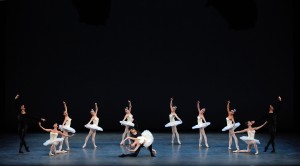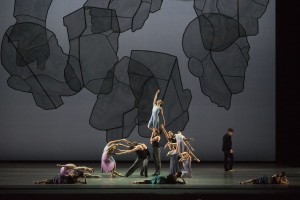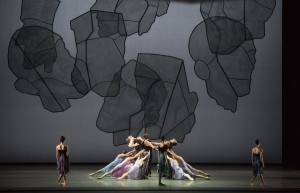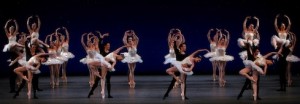MIXED RESULTS FOR ABT’S MIXED REP
As an introduction to American Ballet Theatre’s highly anticipated 4-performance weekend of the full-length Le Corsaire, the company presented a mixed repertory of the old and the new on Thursday. Surprisingly, the results were as mixed as the program itself. As ballet continues to redefine itself in the 21st century, one thing we’ve come to expect from ABT, regardless of whether the piece is classic or modern, is technical proficiency and emotive performances. But a lack of synchronicity and some incongruous casting choices had the first two pieces of the night less than affecting.
 George Balanchine’s Symphony in C, which closed the evening, successfully combined the revered and well-known ABT ballet technique along with an emotional aesthetic. Maestro Ormsby Wilkins and his large orchestra passionately delivered Georges Bizet’s opulent score, and all of the dancers made the typical off-the-floor Balanchine choreography look easy; they were completely synchronized and technically proficient throughout the story-free piece. Some of the partnering lacked fluidity, but the men, most notably Eric Tamm in the first movement and Thomas Forster in the second, offered leaps and turns which defied gravity. The opening stage picture alone – which had the classically posed women dressed in Karinska-styled, white powder-puff tutus subtly lit in gentle blues by Mark Stanley – elicited audible approval. But the roar that greeted the impressive full-ensemble dénouement made it clear that Symphony in C, staged by Merrill Ashley and Stacy Caddell, was far and away the audience favorite.
George Balanchine’s Symphony in C, which closed the evening, successfully combined the revered and well-known ABT ballet technique along with an emotional aesthetic. Maestro Ormsby Wilkins and his large orchestra passionately delivered Georges Bizet’s opulent score, and all of the dancers made the typical off-the-floor Balanchine choreography look easy; they were completely synchronized and technically proficient throughout the story-free piece. Some of the partnering lacked fluidity, but the men, most notably Eric Tamm in the first movement and Thomas Forster in the second, offered leaps and turns which defied gravity. The opening stage picture alone – which had the classically posed women dressed in Karinska-styled, white powder-puff tutus subtly lit in gentle blues by Mark Stanley – elicited audible approval. But the roar that greeted the impressive full-ensemble dénouement made it clear that Symphony in C, staged by Merrill Ashley and Stacy Caddell, was far and away the audience favorite.
The tepid response from the house which followed both Balanchine’s Apollo and Alexei Ratmansky’s Chamber Symphony spoke volumes. The technical proficiency in both works was just as demanding as Symphony in C, so why did the closing piece receive more praise than the others?
 Apollo, set to music by Stravinsky, first appeared in 1928 at Ballets Russes and entered ABT’s repertoire in 1943, but it may no longer hold its aesthetic appeal because of the 70-year culture difference. Back then, it was a major step away from what the audience viewed as traditional ballet, but it just doesn’t translate the same way today. Now, we view Apollo as what trademarked the Balanchine neo-classical ballet style. Although the performances in Apollo were technically precise, the dancers lacked assertiveness; as such, what was once fresh and enthralling no longer captivates in the same way (the staging was by Richard Tanner). Also, the statuesque and charismatic Marcelo Gomes may have offered immaculate skillfulness and boundless dynamism as Apollo, but I would have preferred higher leaps from this grounded dancer. Gomes’s emotive quality was very clear and striking, and his muses (Paloma Herrera, Devon Teuscher, Melanie Hamrick) were entrancing, but this Apollo, however lovely, never truly took flight.
Apollo, set to music by Stravinsky, first appeared in 1928 at Ballets Russes and entered ABT’s repertoire in 1943, but it may no longer hold its aesthetic appeal because of the 70-year culture difference. Back then, it was a major step away from what the audience viewed as traditional ballet, but it just doesn’t translate the same way today. Now, we view Apollo as what trademarked the Balanchine neo-classical ballet style. Although the performances in Apollo were technically precise, the dancers lacked assertiveness; as such, what was once fresh and enthralling no longer captivates in the same way (the staging was by Richard Tanner). Also, the statuesque and charismatic Marcelo Gomes may have offered immaculate skillfulness and boundless dynamism as Apollo, but I would have preferred higher leaps from this grounded dancer. Gomes’s emotive quality was very clear and striking, and his muses (Paloma Herrera, Devon Teuscher, Melanie Hamrick) were entrancing, but this Apollo, however lovely, never truly took flight.
 Ratmansky has an obvious love of Dimitri Shostakovich’s music (conducted here by Charles Barker). His choreography in Chamber Symphony was strong and full of intent, but the pseudo-narrative could be confusing. As a man (James Whiteside) passes between three female partners (Isabella Boylston, Yuriko Kajiya, Julie Kent), the corps is either supporting or thwarting his efforts. Is the movement symbolic of Shostakovich’s life and times or is it about one man’s difficulty with relationships? (The backdrop of George Tsypin’s gigantic scowling faces didn’t help explain things.) Ultimately, the music itself was more melancholic and moody than the scattered dance composition (which just premiered last June).
Ratmansky has an obvious love of Dimitri Shostakovich’s music (conducted here by Charles Barker). His choreography in Chamber Symphony was strong and full of intent, but the pseudo-narrative could be confusing. As a man (James Whiteside) passes between three female partners (Isabella Boylston, Yuriko Kajiya, Julie Kent), the corps is either supporting or thwarting his efforts. Is the movement symbolic of Shostakovich’s life and times or is it about one man’s difficulty with relationships? (The backdrop of George Tsypin’s gigantic scowling faces didn’t help explain things.) Ultimately, the music itself was more melancholic and moody than the scattered dance composition (which just premiered last June).
 On top of that, there was disharmonious execution. Whiteside and the female leads provided visual consistency throughout with elegant, dynamic, and highly evocative movement, but in every major group part there was always one male and female that stood out because his or her execution of the pirouettes, leg extensions, and jetés was more precise and explosive than the rest. We shouldn’t have to wonder if the lack of synchronicity amongst the large group dancers was a choreographic choice or sloppy implementation.
On top of that, there was disharmonious execution. Whiteside and the female leads provided visual consistency throughout with elegant, dynamic, and highly evocative movement, but in every major group part there was always one male and female that stood out because his or her execution of the pirouettes, leg extensions, and jetés was more precise and explosive than the rest. We shouldn’t have to wonder if the lack of synchronicity amongst the large group dancers was a choreographic choice or sloppy implementation.
However uplifting Symphony in C was, the shoulder-shrugging Apollo and the disappointing Chamber Symphony makes me wonder if ABT is second-stringing Los Angeles. Are they saving their best work for their subscription-based home city? Whether for political or artistic reasons, this is what we were offered. Patrons paying up to $125 a ticket deserve better.
photos courtesy of ABT
American Ballet Theatre
Mixed Repertory Program:
Apollo / Balanchine / Music: Stravinsky
Chamber Symphony / Ratmansky / Music: Shostakovich
Symphony in C / Balanchine / Music: Bizet
played July 11, 2013 at 7:30 pm
presented by Glorya Kaufman Dance
The Music Center’s Dorothy Chandler Pavilion
ABT continues with Le Corsaire
Friday, July 12 at 7:30 pm
Saturday, July 13 at 2 and 7:30 pm
Sunday, July 14 at 2 pm
for tickets, visit http://www.musiccenter.org

